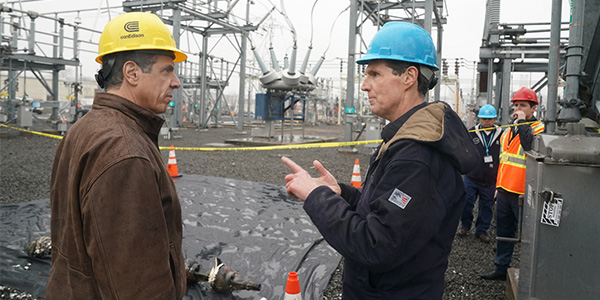By Michael Kuser
After winning a third term in November, Gov. Andrew M. Cuomo last month announced 2019 plans that include tackling climate change with a program reminiscent of Franklin D. Roosevelt’s first 100 days as president during the Great Depression.
“New York must be the most progressive state in the nation moving to renewables,” Cuomo said Dec. 17. “There is new economic growth potential, and New York will launch the Green New Deal to make New York’s electricity 100% carbon neutral by 2040 and ultimately eliminate the state’s entire carbon footprint.”
Cuomo’s effort will build on the state’s energy-related progress over the past year, which included a draft carbon pricing proposal, energy storage programs and new targets for offshore wind and energy efficiency.
The same day Cuomo spoke, the state’s Integrating Public Policy Task Force (IPPTF) met for the last time before handing over its final carbon pricing proposal to IPPTF Hands off Carbon Pricing Proposal to NYISO.)
NYISO and the New York Public Service Commission created the task force in 2017 to explore ways to price carbon into the wholesale electricity markets to align them with state decarbonization policies, including the zero-emission credit program for uneconomic nuclear plants.
NYISO published the IPPTF Carbon Pricing Proposal on Dec. 7 after recommending it no longer require emissions-free resources with existing renewable energy credit contracts pay the carbon component of locational-based marginal prices (LBMPc). The requirement would create “a distortion in the market … that places the ISO in the position of picking winners and losers,” an ISO official said. (See IPPTF Updates Carbon Charge Analysis, Treatment of RECs.)
Offshore Wind is Coming
2018 should prove to be a watershed year for the development of offshore wind, now poised to become a significant source of New York’s energy over the next decade. Early last year, Gov. Cuomo released the comprehensive New York State Offshore Wind Master Plan, which calls for 2.4 GW of offshore resources by 2030.
In July, the New York Public Service Commission authorized state agencies to procure 800 MW by this year. (See NYPSC: Offshore Wind ‘Ready for Prime Time’.) In consultation with the New York Power Authority and the Long Island Power Authority, the New York State Energy Research and Development Authority on Nov. 8 followed up with a request for proposals for 800 MW of offshore wind energy (ORECRFP18-1).
NYSERDA expects to announce the first offshore wind contract award in the second quarter of 2019 and, if needed, issue a second solicitation this year to meet the 800-MW goal of the first tranche.
The U.S. Department of Energy last year awarded a NYSERDA $20.5 million grant to lead a nationwide research and development consortium for the offshore wind industry, with the state matching the federal funds. The consortium in November issued its R&D Roadmap, and in December published its first report, an examination of several technical challenges facing the industry.
The consortium will issue a series of RFPs throughout the four years of federal funding, with the first R&D solicitation planned for next month. Initial project awards are expected to be selected by the end of March.
Energy Storage
New York regulators last month approved measures that will sharply increase the state’s energy storage and efficiency targets. The state’s Department of Public Service and NYSERDA in June issued New York’s Energy Storage Roadmap, and the PSC adopted many of its recommendations.
Rulings by the PSC last year doubled New York’s existing 2025 storage goal to 3,000 MW by 2030 and require the state’s utilities to reduce building energy use by an additional 31 trillion British thermal units (TBtu) to meet an energy efficiency target of 185 TBtu by 2025. (See NYPSC Expands Storage, Energy Efficiency Programs.)
The commission’s Dec. 13 storage order (Case 18-E-0130) said that the targeted deployment of energy storage “will result in reductions in system peak load demand during critical periods, increases in the overall efficiency and resiliency of the electric grid, and displacement of fossil fuel-based generation.”
Resulting public benefits include more than $3 billion in gross lifetime benefits to New York’s utility customers, creation of approximately 30,000 jobs, about 2 million metric tons of avoided greenhouse gas emissions and improved public health by avoiding air-pollutant emissions such as nitrogen oxides, sulfur oxides and particulates.
The order also authorized $310 million in market incentives to be administered by NYSERDA for pairing storage with solar projects, in addition to the $40 million announced the previous month. It also directed the utilities to hold competitive procurements for 350 MW of bulk-sited storage systems.
NYSERDA and the DPS also developed the state-mandated energy efficiency targets (Case 18-M-0084), which now include a 3% annual reduction in electricity sales by 2025 and 5 TBtu of savings from the installation of heat pumps, which help reduce emissions from the heating and cooling of buildings.
CEO Transition
NYISO CEO Brad Jones left the organization abruptly in mid-October and was replaced — at least temporarily — by General Counsel Robert Fernandez. The ISO declined to elaborate on the reason for the departure, except to say it was “a personal decision by Brad.” (See Brad Jones out at NYISO.)
Stakeholders told RTO Insider that senior ISO officials at the time told them the news was a surprise to them. “It’s a really big mystery … it came out of nowhere,” said one stakeholder who asked not to be identified.
The ISO’s Board of Directors has yet to say whether it will initiate a search for another chief executive. Fernandez was named the ISO’s general counsel and chief compliance officer in 2000 after stints at Long Island Lighting Co. and independent power producer Sithe Energies.






